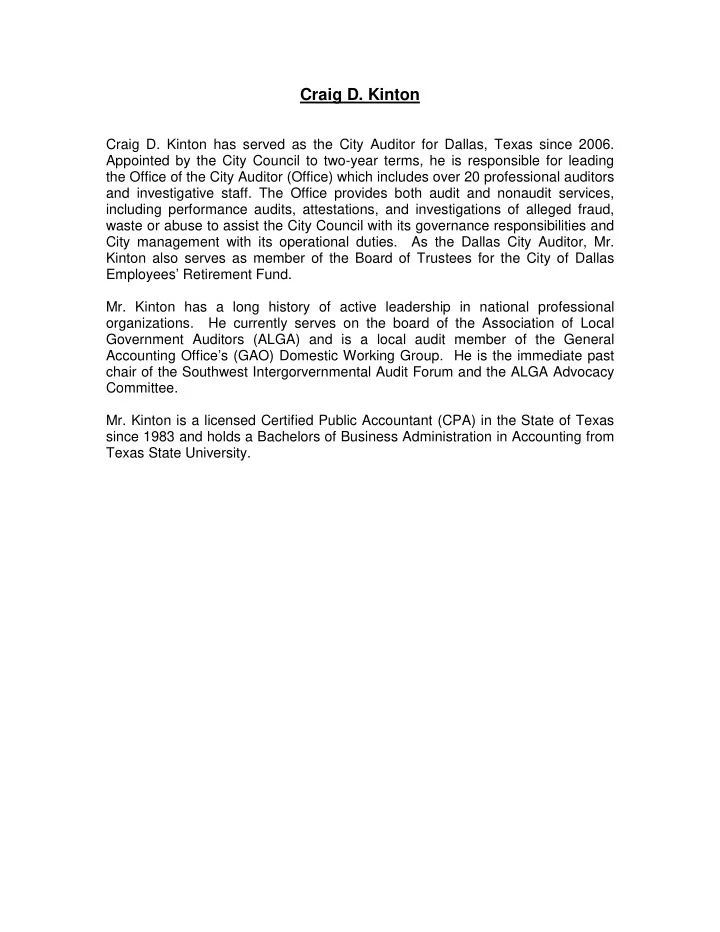

Craig D. Kinton Craig D. Kinton has served as the City Auditor for Dallas, Texas since 2006. Appointed by the City Council to two-year terms, he is responsible for leading the Office of the City Auditor (Office) which includes over 20 professional auditors and investigative staff. The Office provides both audit and nonaudit services, including performance audits, attestations, and investigations of alleged fraud, waste or abuse to assist the City Council with its governance responsibilities and City management with its operational duties. As the Dallas City Auditor, Mr. Kinton also serves as member of the Board of Trustees for the City of Dallas Employees’ Retirement Fund. Mr. Kinton has a long history of active leadership in national professional organizations. He currently serves on the board of the Association of Local Government Auditors (ALGA) and is a local audit member of the General Accounting Office’s (GAO) Domestic Working Group. He is the immediate past chair of the Southwest Intergorvernmental Audit Forum and the ALGA Advocacy Committee. Mr. Kinton is a licensed Certified Public Accountant (CPA) in the State of Texas since 1983 and holds a Bachelors of Business Administration in Accounting from Texas State University.
Craig D. Kinton, City Auditor Office of the City Auditor – Dallas, TX Presented to: Association of Government Accountants – Dallas Chapter October 16, 2014
Simple Definition of Internal Control Internal control is what we do to see that the things we want to happen will happen . . . And the things we don’t want to happen won’t happen. . . . 2
Internal Controls are Common Sense What do you worry about going wrong? What steps have been taken to assure it doesn’t? How do you know things are under control? 3
Definitions of Internal Control COSO Internal Control is a process, effected by an entity’s board of directors, management and other personnel, designed to provide reasonable assurance regarding the achievement of objectives related to operations, reporting, and compliance. 4
COSO Definition Reflects Fundamental Concepts Geared to the achievement of objectives (operations, 1. reporting, and compliance) A process consisting of ongoing tasks and activities – a 2. means to an end, not the end in itself 3. Effected by people – not just policies and procedures but about people and the actions they take Provides reasonable assurance – not absolute assurance to 4. senior management and governance body Adaptable to the entity structure – flexible in application for 5. the entire entity or for a particular subsidiary, division, operating unit, or business process 5
Relationship of Objectives and Components 3 categories Objectives Organizational Components Structure 6
Components of Internal Control Control Environment Comprises: The integrity and ethical values of the organization Parameters enabling the governing body to carry out governance oversight responsibilities Organizational structure and assignment of authority and responsibility Process for attracting, developing, and retaining competent staff Rigor around performance measures, incentives, and rewards 7
Components of Internal Control Risk Assessment Risk is the possibility that an event will occur and adversely affect the achievement of objectives. Risk assessment involves a dynamic and iterative process for identifying and assessing risks to the achievement of objectives. Risk assessment forms the basis for determining how risks will be managed. 8
Components and Principles Risk Assessment The organization: 6. Specifies objectives with sufficient clarity to enable the identification and assessment of risks relating to objectives. 7. Identifies risks to the achievement of its objectives across the entity and analyzes risks as a basis for determining how the risks should be managed. 8. Considers the potential for fraud in assessing risks to the achievement of objectives. 9. Identifies and assesses changes that could significantly impact the system of internal control. 9
Components and Principles Control Activities The organization: 10. Selects and develops control activities that contribute to the mitigation of risks to the achievement of objectives to acceptable levels. 11. Selects and develops general control activities over technology to support the achievement of objectives. 12. Deploys control activities through policies that establish what is expected and procedures that put policies into action. 10
Components of Internal Control Monitoring Activities Ongoing evaluations, separate evaluations, or a combination are used to ascertain whether each of the five components of internal control is present and functioning. Findings are evaluated against criteria established by regulators, recognized standard-setting bodies or management, and the governing board. Deficiencies are communicated to management and the governing board as appropriate. 11
Components and Principles Monitoring Activities The organization: 13. Selects, develops, and performs ongoing and/or separate evaluations to ascertain whether the components of internal control are present and functioning. 14. Evaluates and communicates internal control deficiencies in a timely manner to those parties responsible for taking corrective action, including senior management and the governing board, as appropriate. 12
Management Control Cycle Risk Assessment Control Monitoring Control Environment Activities Information & Communications 13
Limitations of Internal Control Human judgment can be faulty and subject to bias Breakdowns can occur due to human failures (i.e. errors) Management can override internal controls Management, other personnel, and/or third parties can circumvent controls through collusion Costs can exceed benefits Lack of resources can limit implementation or maintenance of controls Organization can be overcome by external events (i.e. pandemic flu/natural disasters) 14
Questions???? 15
Recommend
More recommend